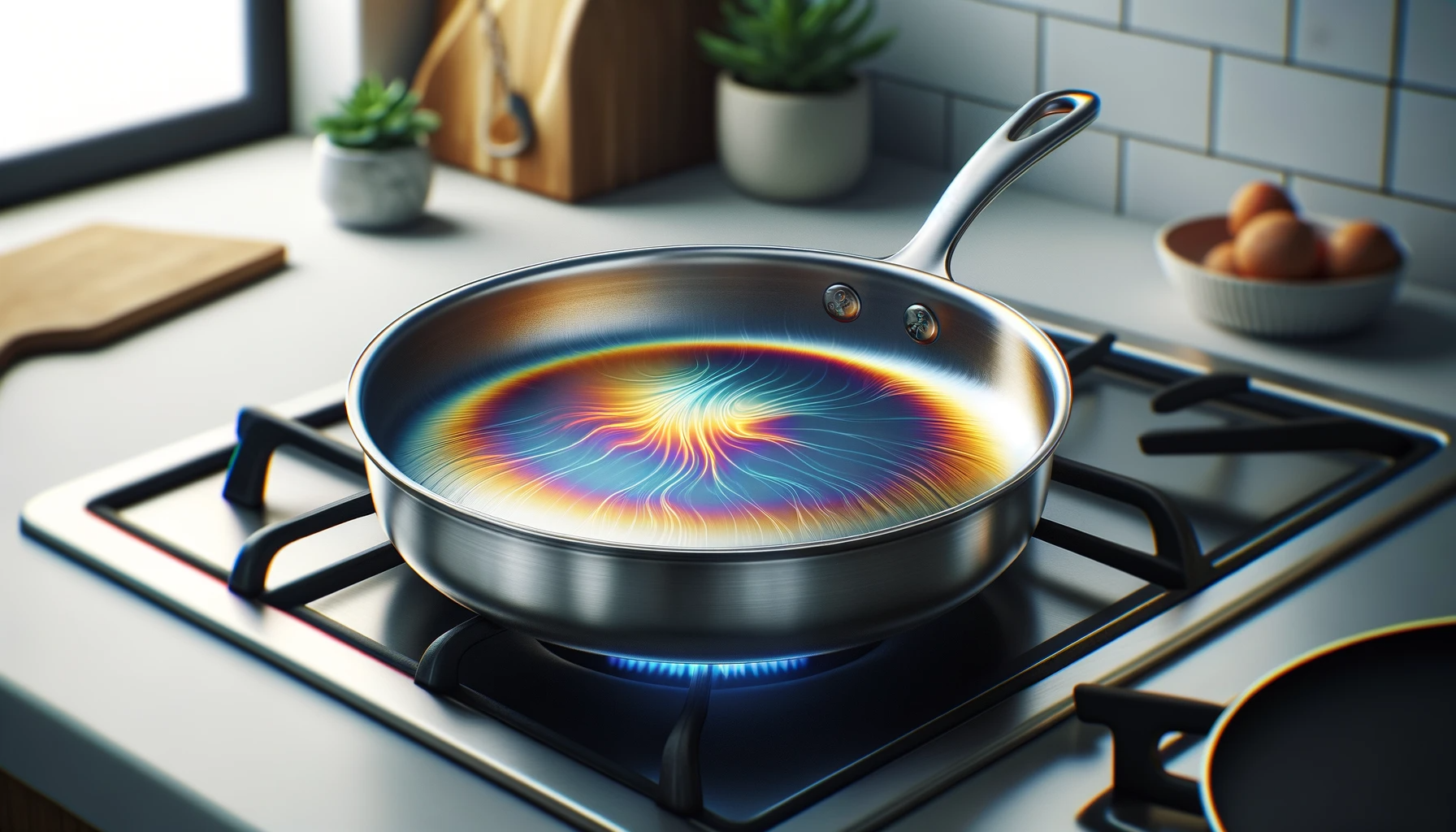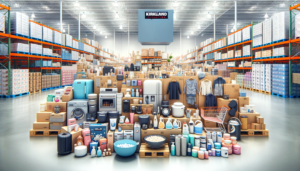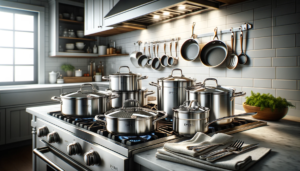Have you ever taken a favorite stainless steel skillet off the stovetop or out of the oven only to find it rainbow colored, dented, or warped in weird ways? Most home cooks think stainless steel indestructible, but it too has limits.
Excess heat absorption causes stainless steel cookware to expand and sustain physical damage beyond reparation affecting its appearance, longevity and functionality.
Let’s examine what happens when stainless steel pans overheat and tips to prevent it.
Can Overheating Damage Stainless Steel Cookware
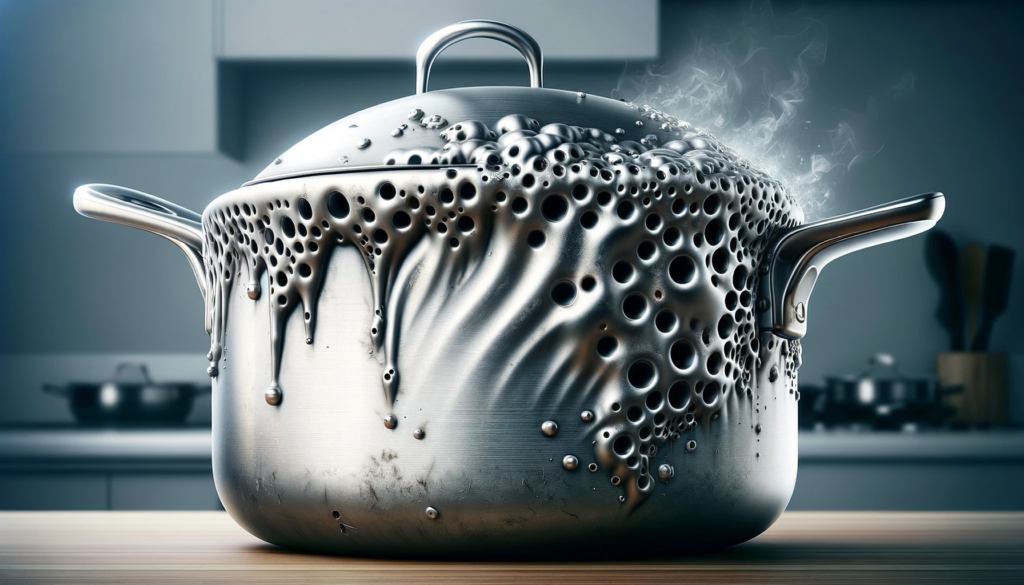
Yes, stainless steel cookware can definitely sustain damage from overheating.
Despite stainless steel’s durability and resilience under high heats, excessively high temperatures ultimately cause the metal to expand, warp out of shape, discolor, and develop tiny perforations over time.
Prolonged exposure to extreme heat also breaks down the protective chromium oxide layer making stainless steel prone to corrosion and rust.
While this wonder metal can withstand more heat stress than others, it too has limits before becoming compromised.
In the sections below we’ll explore in detail how overheating impacts stainless steel pans and pots and best practices to prevent excess heat damage when cooking.
What Happens When Stainless Steel Overheats
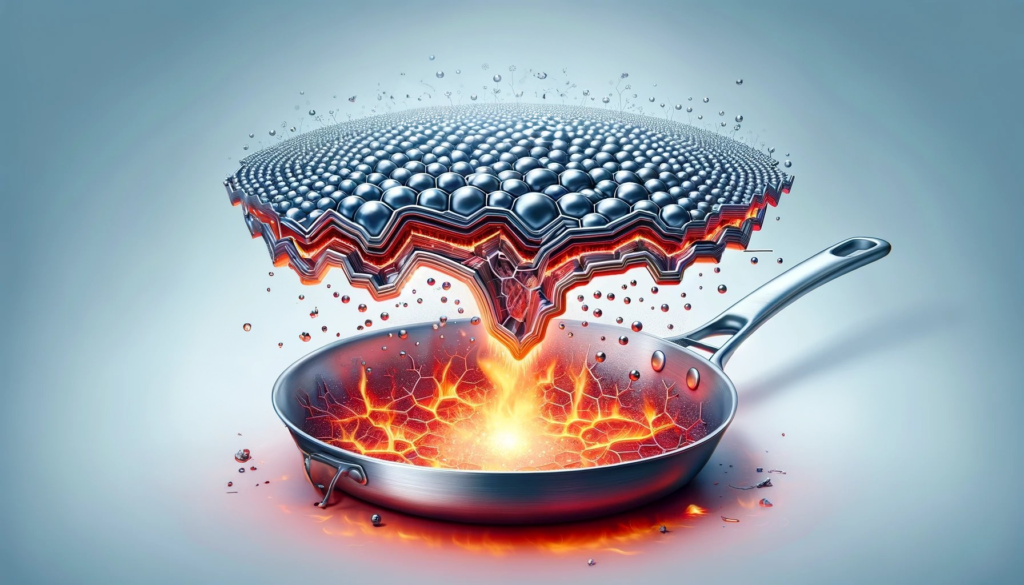
Stainless steel is revered in kitchens worldwide for its modern sleek appearance, ease of cleaning, resistance to stains and rust, and most importantly – its durability under high heats for searing, frying, boiling, braising, and more.
However, while stainless steel has excellent heat conduction properties, it is still possible to subject pots and pans to extreme temperatures that surpass the metal’s structural integrity thresholds.
Exposing stainless steel cookware to excess heat can lead to physical damage altering its functionality, appearance, and longevity.
When stainless steel cookware absorbs high amounts of thermal energy without temperature regulation, the metal itself physically expands as the superheated molecules vibrate rapidly.
If unchecked, this rapid expansion can literally warp pots and pans out of their original intended shapes.
The once smooth, flat bases take on wavy, rippled appearances.
Sides may bow out or bulge, and handles can become misaligned or detach fully.
Permanent dents or bubbles can also form on overheated stainless steel cooking surfaces.
In addition to physical deformities from extreme temperatures, overheated stainless steel’s protective top layer of chromium oxide can break down.
Chromium oxide gives the metal its defining stain and rust resistance.
It creates an inert barrier preventing chemicals in food, water, cleaners and air from penetrating and reacting with the steel itself.
However prolonged or excessive heat destroys chromium oxide, allowing staining, pitting, corrosion spots, and even rust formation to occur.
Blue, brown, yellow, rainbow-like and other odd color distortions also manifest due to unprotected molecules in the bare steel absorbing ambient particles.
Signs of Overheating in Stainless Steel Pans and Pots
Stainless steel cookware stands up to high heat when used properly.
But over time, regularly exposing pots and pans to excess temperatures that surpass stainless steel’s resilience threshold causes cumulative damage.
Subtle early warning signs of overheating in stainless steel cookware typically precede more severe failures as molecules expand, protective coatings break down, and small holes release built up energy.
Catching the early visual indicators of shape irregularities, color distortions, pitting, or loosening components before major catastrophes occur allows cooks to modify habits before cookware becomes unsafe.
Conducting occasional thorough visual inspections alerts stainless steel pot and pan owners to potential overheating risks.
Distorted Shape/Structure:
Visually inspecting for deformities in shape can quickly reveal if stainless steel cookware has sustained excess heat damage.
The sides, edges, walls, handles, and bottoms maintaining alignment and smooth transitions indicate no overheating occurred.
Any rippling, waving, melting, bulging or bubbles signal the steel expanded from absorbing too much thermal energy.
Severe cases can warp pan bases entirely concave or convex.
Discoloration:
While stainless steel has chromium to resist stains, overheating breaks down this protective top layer leading to color distortion.
The steel itself turns various hues including blue, brown, yellow, gold, or rainbow-like patches when overheated.
This effect comes from ambient particles infiltrating unprotected steel molecules missing their chromium oxide barrier.
Minor dark spots or bluish undertones may occur before excessive overheating damage.
Pitting & Perforations:
Tiny holes, pits, gaps, microcracks, bubbles and other indentations scattered throughout the interior cooking surface or exterior sides also indicate overheating occurred.
As steel expands rapidly, small perforations form releasing excess energy.
These holes allow staining, corrosion, and rust formations which further compromise structural integrity.
Detachment of Rivets & Handles:
Another warning sign of stainless steel pans/pots sustaining excess temperatures includes attached components like handles detaching fully or becoming extremely loose.
The rivets, screws, or bonded materials holding handles in place eventually gives way when the steel warps severely or quick expansion puts extreme outward pressure on contact points.
Detached handles become a safety issue making the cookware difficult (or dangerous) to maneuver.
Tips to Avoid Overheating Stainless Steel

Stainless steel cookware is valued in kitchens for its durability, longevity and resistance to corrosion.
However, despite its resilience, stainless steel is still vulnerable to damage if overheated.
Pushing stainless steel cookware beyond its heat limits can lead to warping, staining, rupturing or handle/lid failures over time.
Being mindful of several quick tips when cooking can help avoid excess temperatures that shorten the usable life of stainless steel pots and pans.
Preheat Briefly Without Foods:
Avoid preheating empty stainless steel pans and pots on the highest stovetop heat settings.
Only low to medium heat is needed initially for 1-2 minutes before adding oil, butter, or ingredients.
Preheating without food leads more rapidly to excess temperatures the metal can’t withstand.
Use Right Burner Size:
Choose a stovetop burner appropriately sized to the diameter of the stainless steel cookware for even heat conductivity.
Overpowered large burners under small pots concentrate too much firepower in a small space.
This leads to hot spots warping thinner cookware metals and destroying protective top layers.
Having burner and cookware aligned prevents this excess concentration of heat energy.
No Extreme Temperature Shifts:
When cooking with stainless steel, avoid throwing frozen or very cold foods directly into screeching hot pans.
These sudden, extreme temperature shifts negatively impact the metal leading to quicker warping, perforations, rupturing or detachment issues over time.
Defrost frozen items first or bring chilled ingredients closer to room temp before adding to hot pans helps.
Don’t Leave Unattended On Burner:
It can be convenient to prep other steps of a recipe while pots or pans preheat or simmer on the stovetop.
But unattended stainless steel over prolonged direct high heat leads to excess energy absorption, staining, and structural weakening.
Stay vigilant, stirring periodically and adjusting temperatures up or down to prevent uncontrolled overheating.
Follow Manufacturer Limits:
When using stainless steel pots or pans in the oven check recommended safe temperature limits and avoid the broiler.
While the steel itself can withstand very high oven heat, components like handles or lids may have much lower thresholds before melting, disintegrating or detaching creating injury risks removing cookware.
What to Do if You Overheat Stainless Steel

While durable, stainless steel cookware doesn’t last forever if pushed beyond its heat limits regularly.
Yet tossing damaged overheated pots and pans feels wasteful. In many cases, overheated stainless steel cookware showing slight to moderate wear can be restored to safely extend its usable lifespan.
Employing specific repair techniques matched to the stainless steel’s degree of compromise from excess heat can erase small scars or deformations.
However, severely compromised cookware should be retired and replaced for safety.
Reshape Slightly Warped Pans:
If stainless steel pans warp only mildly from overheating, reshape them once fully cooled.
Gently bending by hand or padding a warped surface to press back into its original form realigns the steel.
Spot heat warping gently under low broil oven temperatures holding the pan 6-inches away from element.
This allows controlled expansion to regain proper shape.
Avoid hammering misshapen cookware.
Use Stainless Steel Polish:
Overheated stainless steel prone to staining can be resealed using a specially formulated steel polish or cleanser.
These products fill in microabrasions in the chromium oxide top layer.
Gently rubbing polish into the full interior cooking surface and exterior sides recreates a water-repellent barrier keeping stains at bay.
Apply High Heat Repair Coatings:
For discoloration like blue, brown or rainbow hues on overheated stainless steel, apply high heat paints and coatings specially made for the metal.
Available online or at hardware stores, these repair compounds fill in porous steel compromised at excess temperatures.
Allow proper drying and curing before putting coats to the test in cooking.
Multiple thin layers enhance durability.
Replace Dangerously Compromised Items:
Severely overheated stainless steel cookware with extreme warping, bubbling, massive holes/gaps, detached components or rust risks becoming hazardous to handle safely.
Repairing these items costs exceeds replacing them.
Compromised overheated stainless steel cookware has greatly shortened safe use lifespans anyway, making new well-constructed replacements the wise investment choice.
Conclusion
In conclusion, while stainless steel’s durability makes it less prone to damage, extreme overheating can still warp, discolor or perforate pots and pans compromising their structure and performance.
Following safe cooking practices keeps stainless steel intact for longterm use.
Know the visual warning signs of overheating and avoid subjecting cookware to excess temperatures whenever possible.
Proper care preserves stainless steel’s cooking functionality for years beyond other lesser metals.
